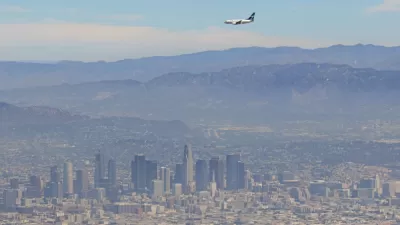The 16th annual State of the Air report includes everyone's favorite tool for putting the achievements of cities and metropolitan areas in perspective: rankings.
The American Lung Association has released the results of its 16th annual "State of the Air" report, finding that "more than 4 in 10 people in the United States live in counties that have unhealthy levels of either ozone or particle pollution."
According to a press release announcing the report, many parts of the country are making encouraging progress in the "long fight for cleaner, healthier air for all Americans." In fact, "[th]e best progress showed in levels of year-round particle pollution, which have been steadily improving. For that you can thank the transition to cleaner diesel fuel and engines and steps taken to clean up power plants, especially in the eastern U.S.," according to the press release.
Not all the news was good, however. Some cities got worse for ozone levels, and "[d]angerous short-term spikes in particle pollution increased in many cities, particularly in the western U.S., with some cities showing their worst problems since the report began." That latter issue has everything to do with climate change, according to the press release.
In addition to the policy recommendations included in the report and summarized in the press release, the State of the Air study includes a ranking of metropolitan areas, best and worst, on three measures of air pollution: Ozone, Year-Round Particle Pollution, and Short-Term Particle Pollution. The most polluted and cleanest cities on those measures are as follows:
Most Polluted
Ozone: Los Angeles, California
Year-Round Particle Pollution: Fresno-Madera, California
Short-term Particle Pollution: Fresno-Madera, California
Cleanest
Ozone: Bellingham, Washington
Year-Round Particle Pollution: Prescott, Arizona
Short-term Particle Pollution: Alexandria, Louisiana
FULL STORY: Every Breath You Take: State of the Air 2015

Study: Maui’s Plan to Convert Vacation Rentals to Long-Term Housing Could Cause Nearly $1 Billion Economic Loss
The plan would reduce visitor accommodation by 25,% resulting in 1,900 jobs lost.

Alabama: Trump Terminates Settlements for Black Communities Harmed By Raw Sewage
Trump deemed the landmark civil rights agreement “illegal DEI and environmental justice policy.”

North Texas Transit Leaders Tout Benefits of TOD for Growing Region
At a summit focused on transit-oriented development, policymakers discussed how North Texas’ expanded light rail system can serve as a tool for economic growth.

Paris Bike Boom Leads to Steep Drop in Air Pollution
The French city’s air quality has improved dramatically in the past 20 years, coinciding with a growth in cycling.

Why Housing Costs More to Build in California Than in Texas
Hard costs like labor and materials combined with ‘soft’ costs such as permitting make building in the San Francisco Bay Area almost three times as costly as in Texas cities.

San Diego County Sees a Rise in Urban Coyotes
San Diego County experiences a rise in urban coyotes, as sightings become prevalent throughout its urban neighbourhoods and surrounding areas.
Urban Design for Planners 1: Software Tools
This six-course series explores essential urban design concepts using open source software and equips planners with the tools they need to participate fully in the urban design process.
Planning for Universal Design
Learn the tools for implementing Universal Design in planning regulations.
Smith Gee Studio
Alamo Area Metropolitan Planning Organization
City of Santa Clarita
Institute for Housing and Urban Development Studies (IHS)
City of Grandview
Harvard GSD Executive Education
Toledo-Lucas County Plan Commissions
Salt Lake City
NYU Wagner Graduate School of Public Service




























